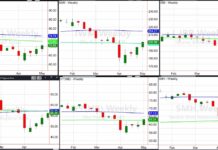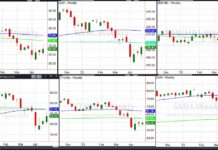Monetary Existentialism
People who study the theory of money have always struggled with the epistemology. Economist Arnold Kling quotes this from historian Yuval Harari’s Sapiens: A Brief History of Humankind:
Money. . .involved the creation of a new inter-subjective reality that exists solely in people’s shared imaginations.
But I think Kling found a better definition [Emphasis mine]:
I like to say that money is a consensual hallucination…
(Will gold bugs troll me for this?)
The Fed as the Timothy Leary of Market Consciousness?
The market reaction to Wednesday’s FOMC rate decision reminded me of this quote from Hunter S. Thompson’s Fear and Loathing in Las Vegas
“We’re all wired into a survival trip now… no more of the speed that fueled the 60′s. That was the fatal flaw in Tim Leary’s trip. He crashed around America selling consciousness expansion, without ever giving a thought to the grim meathook realities that were lying in wait for all those peoples who took him seriously. All those pathetically eager acid freaks who thought they could buy peace and understanding for three bucks a hit. but their loss, and failure, is ours too. What Leary took down with him was that the central illusion of a whole lifestyle that he helped create… a generation of permanent cripples, failed seekers, who never understood the essential old mystic fallacy of the acid culture. The desperate assumption that somebody, or at least some force, is tending the light at the end of the tunnel. [Emphasis mine.]
I don’t want to take that analogy too far and I think we’re not (yet? again?) feeling any “grim meathooks”. But there is something to it. The Fed was clear that they were revising downward their current economic projections and stated clearly that they we’re not looking at a rate increase in their April meeting. Of note was the passing mention of headwinds to exports created by a strong Greenback. We won’t know the depth of that discussion until the meeting minutes are released.
But the market cheered the bad news as though the bus Further unloaded all of the Merry Pranksters who stumbled out with a promise to keep the parties going. Wednesday was just another one of many stops that we’ve witnessed since the Global Financial Crisis. There’s still some gas in the tank and we’ll see how many more stops the Pranksters’ bus can make on the road to normal.
[Note: Lest I appear as a Fed hater by proffering that the Fed is nothing but gang of drug dealers, I certainly don’t hold that opinion – at all . It’s true that I’m a Fed skeptic. I also think the body operates with the best intentions through a panel of very smart people. My lack of faith in the Fed is no more than my lack of faith in macroeconomics as a set of useful policy tools. I suppose this is where the insertion of quotes from Freddy Hayek would be apt. But I prefer avoiding the Pretence of Austrianism as to save whatever is left of my good name with economic partisans.]
We are, however, talking about money in a royal sense. Money is, we now know, contrived in our mutual imagination. With that we must ask:
What’s a Fed to do?
If you haven’t taken the time to read Vice Chairman Stanley Fischer’s speech of October 11, 2014 you miss important aspects of the Fed’s internal dialogue.
While reserving my right to be wrong, it appears to me that the Fed has more concern about the rate of change of the dollar than its nominal strength. After all, dollar strength offsets weak exports with less expensive imports in terms of GDP.
Fischer’s remarks go deep into the global responsibility of the world’s most important central bank. This, however, may shed some light [again, emphasis mine]:
But I should caution that the responsibility of the Fed is not unbounded. My teacher Charles Kindleberger argued that stability of the international financial system could best be supported by the leadership of a financial hegemon or a global central bank. But I should be clear that the U.S. Federal Reserve System is not that bank. Our mandate, like that of virtually all central banks, focuses on domestic objectives. As I have described, to meet those domestic objectives, we must recognize the effect of our actions abroad, and, by meeting those domestic objectives, we best minimize the negative spillovers we have to the global economy. And because the dollar features so prominently in international transactions, we must be mindful that our markets extend beyond our borders and take precautions, as we have done before, to provide liquidity when necessary.
In other words, the Fed pays attention to currency knock-on effects but keeps domestic policy as the primary objective. Given an estimated $7 trillion in non-financial foreign dollar denominated debt the concern about a currency shock becomes more acute. Even a small rise in U.S rates will add to dollar strength. In the face of almost every other central bank adding some form for monetary easing, a U.S. rate rise exaggerates dollar strength. In that context the Fed understands the fine line between domestic objectives and allowing time for global interests to adjust.
The language in Wednesday’s FOMC release was just a small tap on the brakes to accommodate such adjustments but does not change the eventual trajectory of Fed policy objectives – which, as they’ve said, is a return to normalization. I do not think that the Fed sees any urgent need to raise rates given the policy parameters of employment and inflation. The Fed does, however, understand the the long transmission lag-time of rates moves.
I also think that the Fed keeps its reputational risk center stage. As I said in my last post, they want the markets to be less dependent on forward guidance. The context for this worry is at least as political as it is policy driven given the Audit the Fed pressure in Congress. Again reserving my right to be wrong, my guess is that the Fed is worried about disequilibrium in asset risk premia (I dare not say “bubbles”) and fear being blamed for a potential large draw-down should it happen.
To wit:
Fed’s trying to wean the monkeys off bananas, but monkeys will only listen if they think they’re getting offered more bananas. #dilemma
— Mark Dow (@mark_dow) March 18, 2015
Yes, the Fed can couch its work in all kinds of economic modeling but in the end it simply boils down to managing expectations of our consensual hallucination. The Fed should hire Wavy Gravy as their spokesman.
Govern Yourselves Accordingly
People who know me understand that I’m not a doomsayer or a Pollyanna. I couch my opinions in Socrates: Wisdom is the understanding of our own ignorance. But there are risks which, if ignored, could end up as alpha killers. Stocks are very expensive by many historical measures. Top of my list is a derivative chain tripwire too close to central bank jawbones. Who knows if there’s a LTCM out there positioned way off-sides. So, to borrow from Wavy Gravy, I’m only taking half a tab.
I’m avoiding the stupid “no matter where the dollar goes it’s good to stocks” nonsense heard on Twitter and TV this week. This is pretty simple: Dollar strength effects exports the opposite of imports. Profits will be effected accordingly. You can’t teach an old math new tricks.
I will say that I think the dollar goes higher given the monetary easing everywhere but here. Nothing moves in a straight line and we’ll get some back-fill along the way. Caveat emptor: I’ve been wrong before – a lot.
Non-errata
Ugh, how many times must football be distracted with this kind of behavior?:
One of the Baltimore Ravens Just Published an Insanely Complex Study in a Math Journal
H/T @IvanTheK
Zeitgeist
The clarity of an angry anarchist cleaning his guns? RT @daytrend: Taxes done yesterday. Mind clear… Priceless.
— Old Bull Lee (@davebudge) March 15, 2015
I’ve said enough for now. Don’t applaud all at once. I think I’ve lived up to my promise that I’ll leave you with more questions than answers.
Trade ’em well and be careful out there. The stuff that kills you always comes from where you’re not looking.
-db
Follow Dave on Twitter: @davebudge
Any opinions expressed herein are solely those of the author, and do not in any way represent the views or opinions of any other person or entity.








